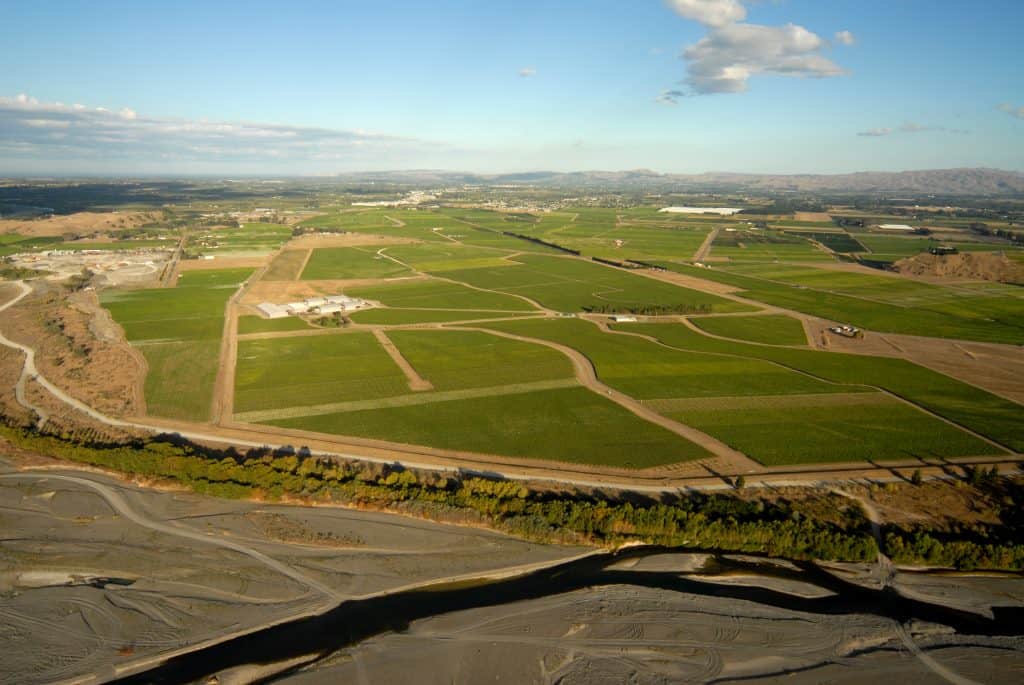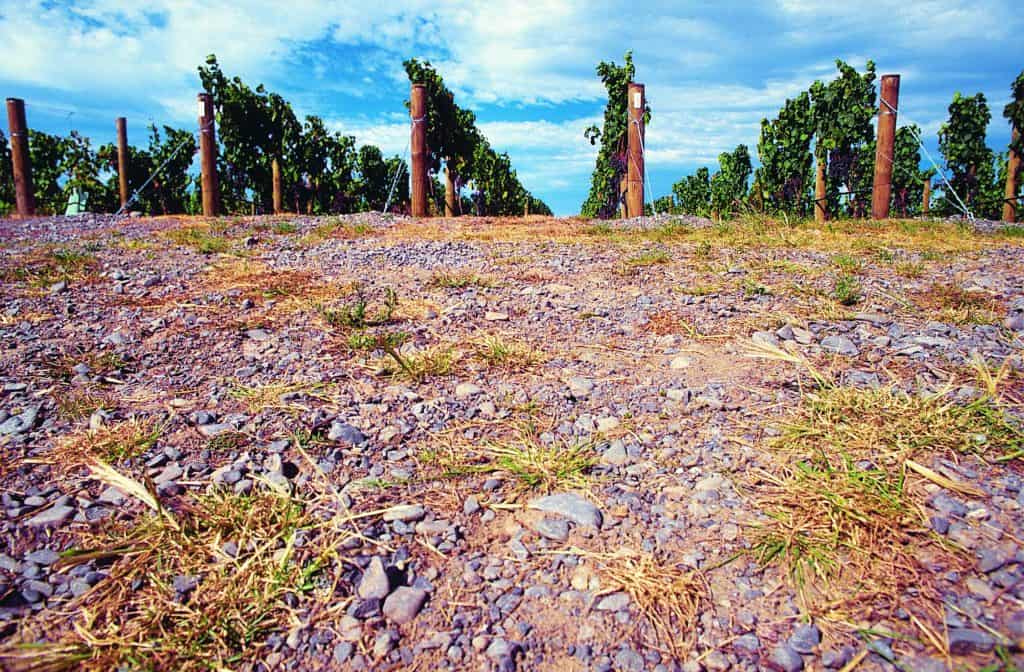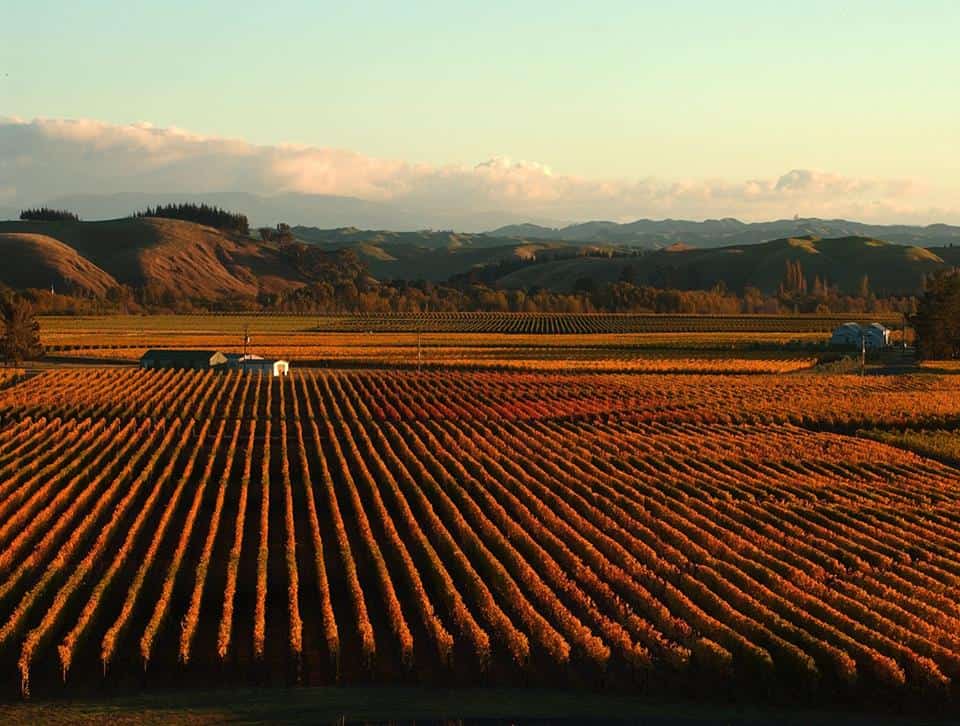Gravel is a word used in conjunction with some of wine’s most hallowed ground. The gravelly clays of Bordeaux’s Left Bank produce bottles bearing vaunted names such as Haut-Brion, Latour, Lafite, Mouton, and Margaux.
After the example set by Bordeaux, alluvial soils are prized the world over for winegrowing, though only a few regions have used them to such great advantage. One of the other areas that has exploited its alluvium for fame and fortune can be found on the eastern side of New Zealand’s North Island.
There, where Heretaunga Plains back up against the foothills of the Kaweka mountains, the vineyards sprawl in wide swaths, interrupted by small streams and hillocks buffeted by breezes off of Hawke’s Bay, in a region that has been dubbed the Gimblett Gravels.

Don’t Call it an Appellation
It might surprise many to know it, but the New Zealand government only formally developed and legalized its geographical indications, or wine appellations, in 2016. This despite more than 100 years of winegrowing history and a modern wine industry that has grown steadily since the 1960s.
When the government did define the country’s wine regions, they chose to do so only with a broad brush, defining a mere 18 GIs, and ignoring the many sub-regional designations that had been in place for decades prior.
In fact, winegrowers in New Zealand have long been frustrated with the lack of clearly defined appellations in the country, which is why in 2001 a bunch of growers got together and defined the Gimblett Gravels Winegrowers Association.
Like other sub-regions of the area, such as Havelock and Esk Valley, people have been referring to the Gimblett Gravels as a distinct winegrowing area for decades. Without the benefit of a governmental designation, the folks at the GGWA did the next best thing. They went ahead and defined it themselves, exactly the same way that the government might have done.
The growers in the area sat down, argued for a long time about what should truly define the region, and then forged a consensus about the boundaries and definition of their place. Interestingly, they settled on defining the boundaries of the Gimblett Gravels strictly based on soil geology.
While Gimblett Gravels® is a registered commercial trademark managed by its winegrowers association, it is managed with the same (or more) rigor as many standard appellations around the world. If you want to have the words Gimblett Gravels on your wine label, you have to have a vineyard within the boundaries of the designated region, with 95% of the vineyard area having any of three defined soil types, and 95% of the fruit needs to have come from within the district.

The “map” of the district has been drawn to only include the three types of gravelly silt and loam laid down by the Ngaruroro River and observes no other political, geographical, or property ownership distinctions, a point that the Gimblett Gravels Association likes to suggest lends something of a simple purity to their efforts. If you’ve got the soils, you’re in (provided you want to pay membership dues). If you don’t, you’re out.
There are around 1975 acres of vineyards that fall within the Gimblett Gravels zone, the vast majority of those (close to 90%) planted to red grapes, with Syrah and the Bordeaux varieties dominant.
While moderated by the nearby ocean, Hawke’s Bay is the warmest of all New Zealand’s wine regions, and the Gimblett Gravels might easily be described as the warmest bits of Hawke’s Bay.
This shorthand, however, somewhat obscures the fact that “warm” for New Zealand is fairly temperate for most other wine regions. Compared to Paso Robles or the Douro, Hawke’s Bay still comes across as pretty cool, and you can easily find corresponding flavor signatures in the wines, especially the Syrahs.

An Idyllic Vintage
In a world where it seems like every year we’re hearing of some vintage disaster in one place or another, a normal growing year feels like a blessing. In fact, 2020 in the Hawke’s Bay region was near perfect, if only just slightly warmer than usual. No adverse weather events affected the growing season or harvest, allowing winemakers the rare luxury of making the wines they wanted to make.
That is, once they were allowed to make it.
Despite avoiding the fate of much of the world when it came to the COVID-19 pandemic, New Zealand was unable to keep the virus out of the country entirely, and when it did rear its head, the government dealt with it swiftly and severely.
This meant total lockdowns when cases appeared, which they did right around the time of harvest in 2020. Thankfully, special dispensation was given to winemakers, allowing them to harvest and process their fruit, saving a perfect vintage from a near-perfect disaster.

The Ideal Case
For the past 12 years, the winemakers in the Gimblett Gravels Association have been putting together a case of wines (selected via blind tasting by the Australian Master of Wine Andrew Caillard), to send out to journalists and critics around the world as an example of what the vintage was like in the region.
This is now the second year I’ve been receiving this vintage selection case and I remain impressed with the idea, and with the wines, which are uniformly delicious. More regions around the world should consider offering such snapshots to journalists who don’t have the chance to visit as often as they’d like.
So here’s what 2020 tastes like in the Gimblett Gravels.
Tasting Notes
Be aware that some of these wines are made in such small quantities that they don’t end up in the United States. In other cases, the 2020 vintage of these wines has not yet made the journey to these shores. The purchase links below will therefore take you to any and all vintages of the wine that are for sale, including the 2020s when they become available.

2020 Church Road “1 – Single Vineyard” Cabernet Sauvignon, Gimblett Gravels, Hawke’s Bay, New Zealand
Dark garnet in the glass, this wine smells of cherry and hints of cola. In the mouth, exuberant and bright cherry flavors mix with a hint of floral perfume and tangy sour cherry notes that accompany boisterous acidity. This is just a cherry party in your mouth. Light, suede soft tannins and some dried herb and sweet oak notes make sure this isn’t all fruit all the time, but this slot machine is definitely coming up all cherries. 14% alcohol. Score: between 9 and 9.5. Cost: $75.
2020 Church Road “1 – Single Vineyard” Malbec, Gimblett Gravels, Hawke’s Bay, New Zealand
Very dark garnet in the glass with purple highlights, this wine smells of blueberries and blackberries. In the mouth, juicy blueberry and blackberry fruit is shot through with powdery, stony tannins and topped off with floral and dried herb notes. Excellent acidity and wonderful length, this wine soars across the palate. 14.5% alcohol. Score: between 9 and 9.5. Cost: $75.
2020 Esk Valley “Artisanal Collection” Bordeaux Blend, Gimblett Gravels, Hawke’s Bay, New Zealand
Dark garnet in the glass, this wine smells of plum, blueberry, and black cherry. In the mouth, wonderfully vibrant black cherry, black tea, and dark plum flavors have a meaty-umami kick to them as well as a bright citrus peel acidity that lingers through a long finish. Fleecy tannins offer a light touch, leaving a faint sensation of muddy river water in the aromatic finish. A blend of 44% Merlot, 30% Cabernet Sauvignon, and 26% Malbec. 14% alcohol. Closed with a screwcap. Score: between 9 and 9.5. Cost: $??
2020 Elephant Hill Winery “Stone” Bordeaux Blend, Gimblett Gravels, Hawke’s Bay, New Zealand
An inky, opaque garnet in the glass, this wine smells of black cherry and earth. In the mouth, rich black cherry, cola, and black plum notes mix with hints of dried herbs and potting soil. Dark and rich but without feeling heavy. The tannins are very fine and tight, but not aggressive. I suspect this wine will blossom nicely over the next 10 years. A blend of 50% Merlot, 25% Cabernet Franc, and 25% Cabernet Sauvignon. 14.5% alcohol. Closed with a screwcap Score: around 9. Cost: $50.
2020 Elephant Hill Winery “Heironymous” Bordeaux Blend, Gimblett Gravels, Hawke’s Bay, New Zealand
Dark garnet in the glass, this wine smells of black cherry, a touch of oiled leather, and meat. In the mouth, savory notes of black cherry and blackberry mix with a more bloody, meaty character that resolves to something faintly saline. This salinity, combined with the very good acidity makes for a mouthwatering package. Faint tannins. A blend of 60% Cabernet Sauvignon, 20% Malbec, and 20% Merlot. 14% alcohol. Closed with a screwcap. Score: around 9. Cost: $80.
2020 Babich “Single Vineyard – Winemaker’s Reserve” Merlot, Gimblett Gravels, Hawke’s Bay, New Zealand
Dark garnet in the glass, this wine smells of black plum and cola. In the mouth, plum, cola, and cherry flavors are bright with juicy acidity as faint, fleecy tannins caress the palate. Excellent acidity and length, leaving hints of citrus peel and dried herbs in the finish. 14% alcohol. Score: around 9. Cost: $??.
2020 Trinity Hill “The Gimblett” Bordeaux Blend, Gimblett Gravels, Hawke’s Bay, New Zealand
Very dark garnet in the glass, this wine smells of dried flowers, black cherry, black plum, and blackberry. In the mouth, extremely juicy flack cherry and blackberry flavors are shot through with excellent citrus peel acidity as wispy tannins caress the palate. Dried herbs and bright citrus oil mark the finish. Excellent. A blend of 50% Cabernet Franc, 33% Cabernet Sauvignon, and 17% Merlot. 14% alcohol. Closed with a screwcap. Score: between 9 and 9.5. Cost: $25. click to buy.
2020 Squawking Magpie “The Stoned Crow” Syrah, Gimblett Gravels, Hawke’s Bay, New Zealand
Dark garnet in the glass, this wine smells of blackberries and dried flowers. In the mouth, the wine proves almost explosively juicy, with ripe and under-ripe blackberries offering a tangy, juicy, mouthwatering dance across the palate. Hints of dried herbs and flowers linger in the finish as the salivary glands kick into overdrive. Impressive. 14% alcohol. Closed with a screwcap Score: between 9 and 9.5. Cost: $35.

2020 Stonecroft “Reserve” Syrah, Gimblett Gravels, Hawke’s Bay, New Zealand
Dark garnet in the glass, this wine smells of blueberry and black cherry. In the mouth, juicy blueberry and blackberry fruit have an astonishing minty freshness to them and a wonderful powdered stone tannic texture that fills the mouth. Excellent acidity keeps everything juicy and bright. Excellent. 13.5% alcohol. Score: between 9 and 9.5. Cost: $35.
2020 Craggy Range “Le Sol” Syrah, Gimblett Gravels, Hawke’s Bay, New Zealand
Dark garnet in the glass, this wine smells of blackberries, blueberries, and fried pancetta. In the mouth, faintly saline flavors of blackberry and dashi mix with blueberries and dried herbs. Fleecy, muscular tannins squeeze the palate slightly, as excellent acidity carries the wine through a long finish. 14% alcohol. Closed with a screwcap. Score: around 9. Cost: $90. click to buy.
2020 Trinity Hill “Homage” Syrah, Gimblett Gravels, Hawke’s Bay, New Zealand
Very dark garnet in the glass, this wine smells of blackberries and blueberries. In the mouth, cool, stony flavors of blackberry and blueberry are backed by a fine-grained, powdered stone tannic spinal column that remains quite supple. Excellent acidity brings notes of citrus peel and dried herbs into the finish, and keeps the wine quite fresh and juicy. Regal and poised. Excellent. 13.5% alcohol. Score: between 9 and 9.5. Cost: $95. click to buy.
2020 Mission Estate Winery Jewelstone Bordeaux Blend, Gimblett Gravels, Hawke’s Bay, New Zealand
Dark garnet in the glass, this wine smells of cedar and cigar box, with dark red fruit underneath. In the mouth, pipe tobacco, black cherry, and plum mix with espresso and a touch of leather. Muscular, fine-grained tannins are slightly drying in the mouth. This wine needs a little time to integrate. Good acidity, with hints of green herbs lingering in the finish. A blend of 75% Merlot, 20% Cabernet Sauvignon, and 5% Cabernet Franc. 14% alcohol. Score: between 8.5 and 9. Cost: $??
Images courtesy of the Gimblett Gravels Winegrowing Association.